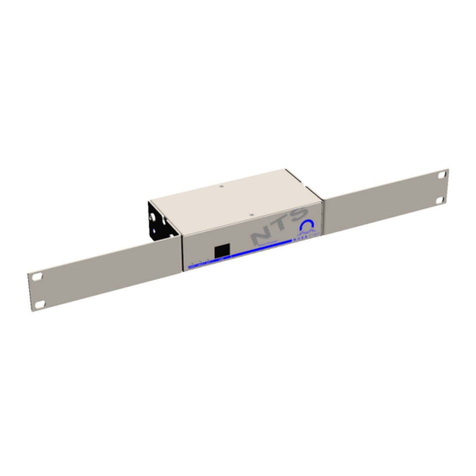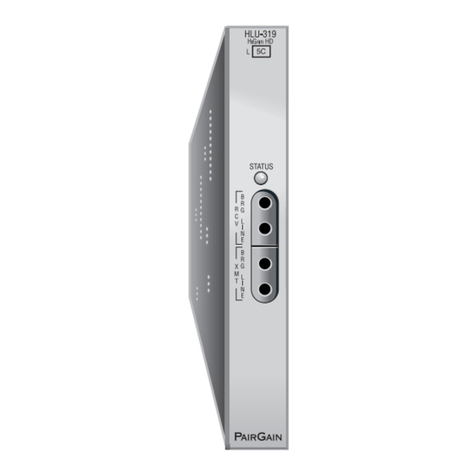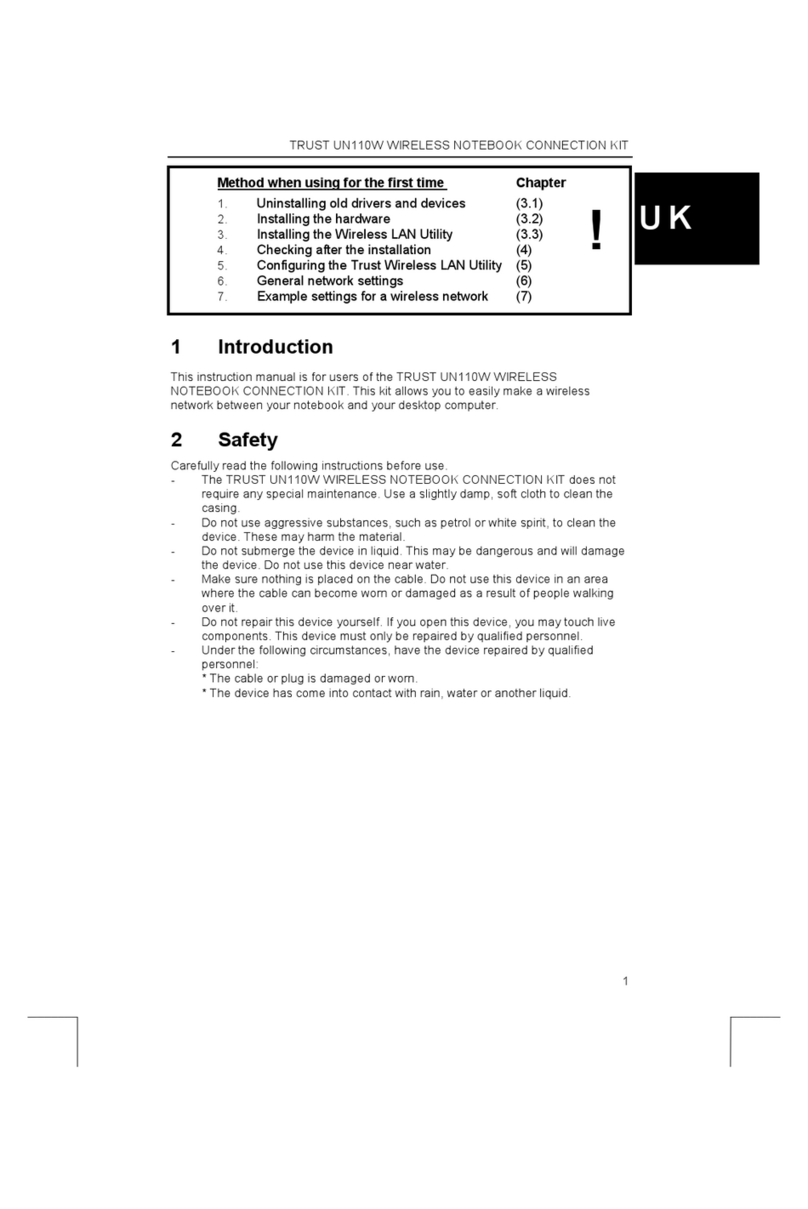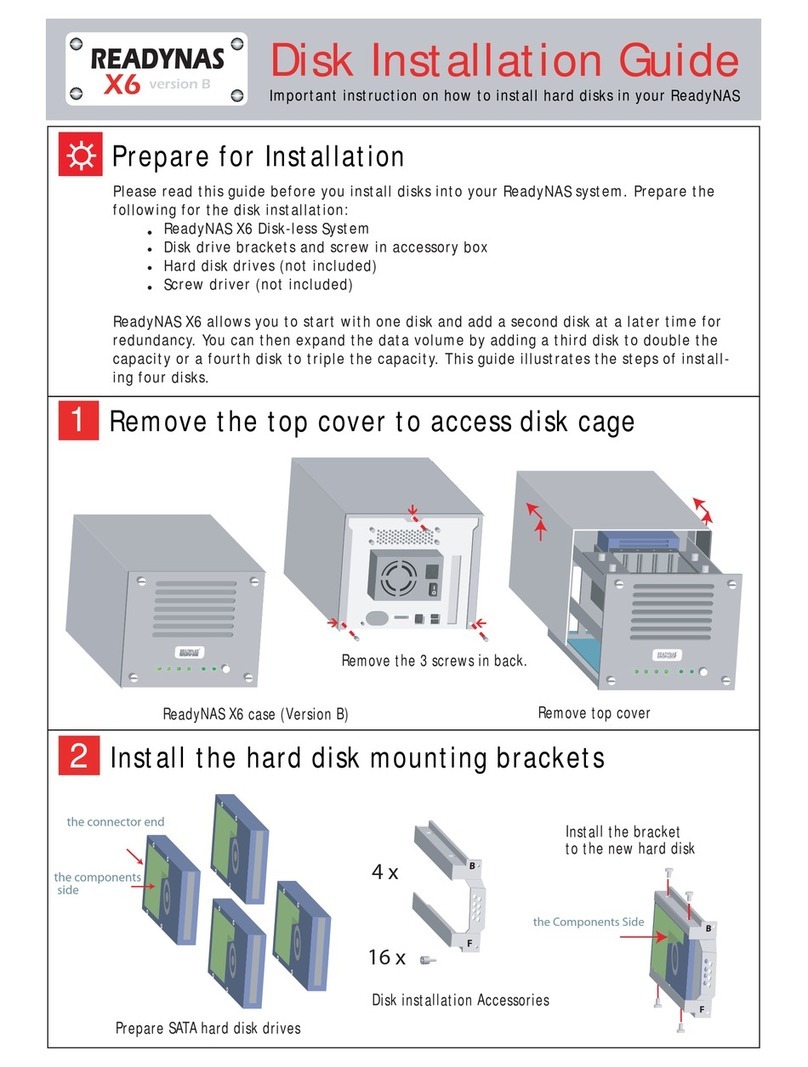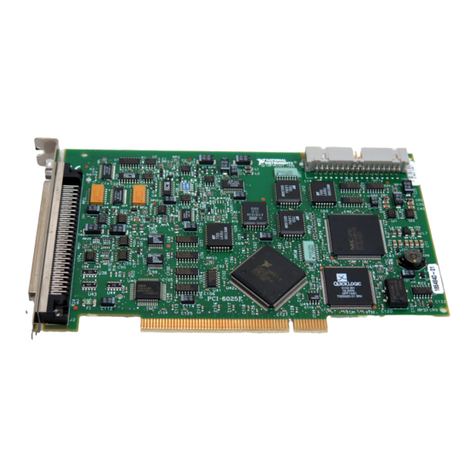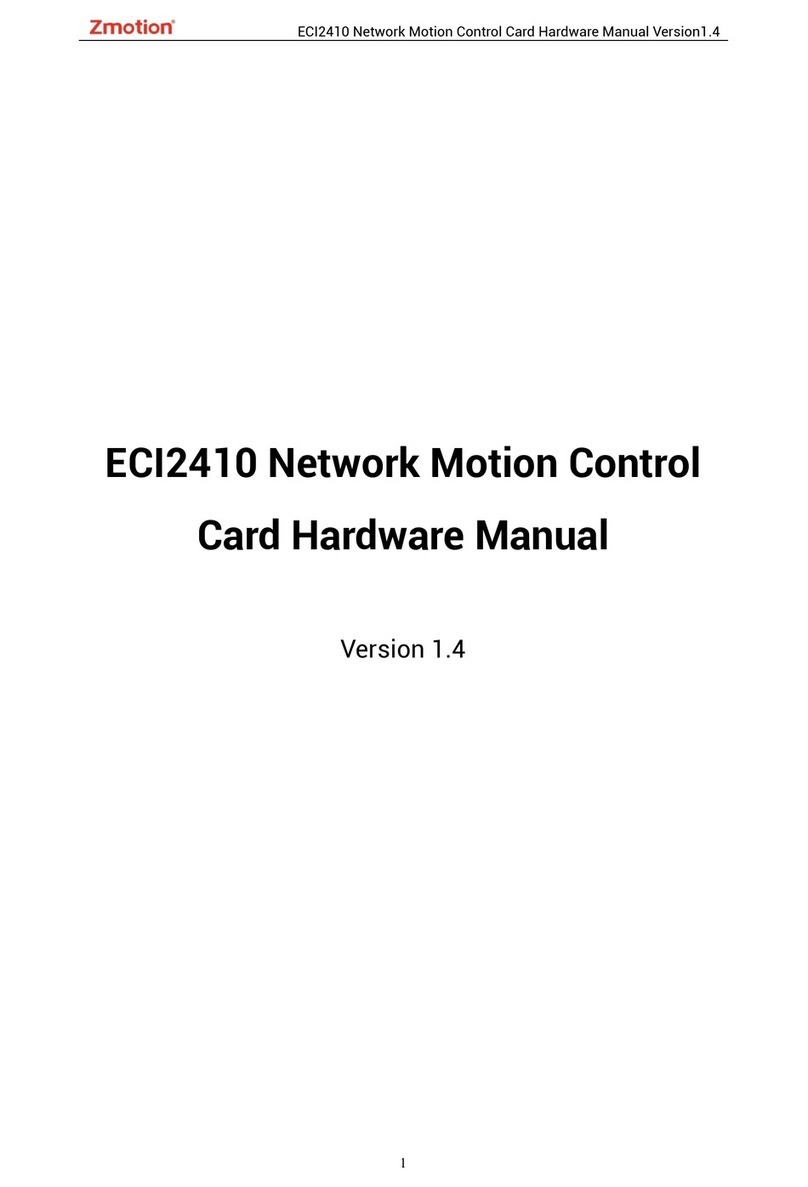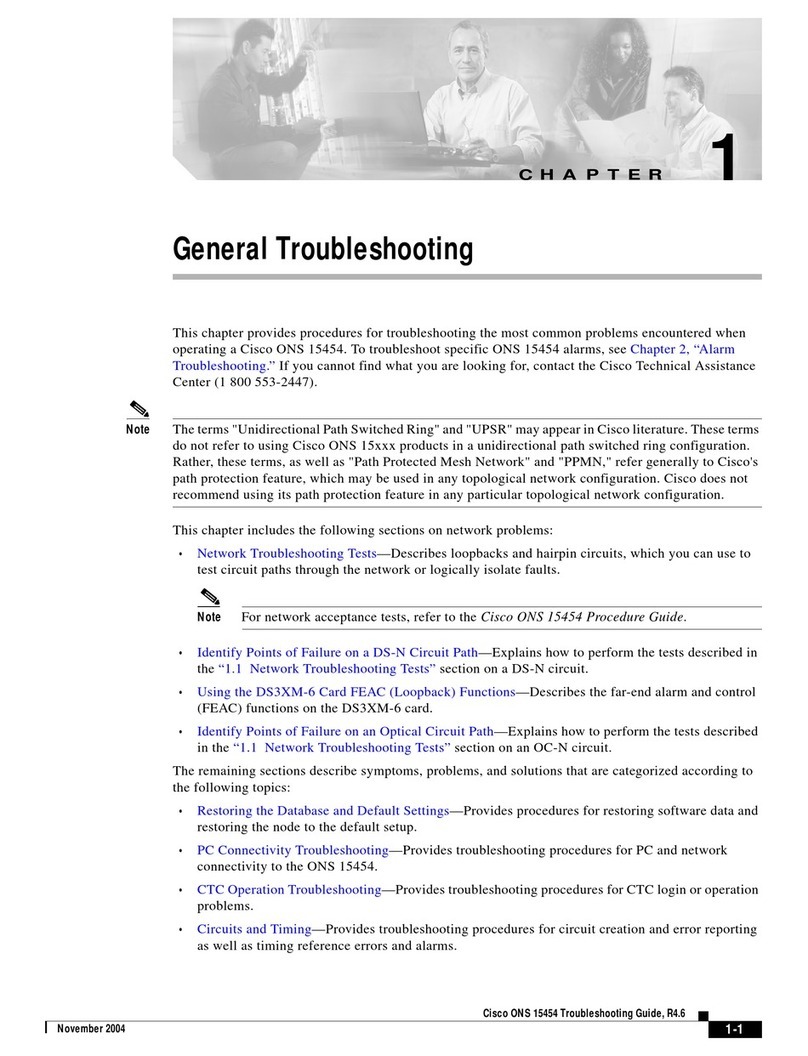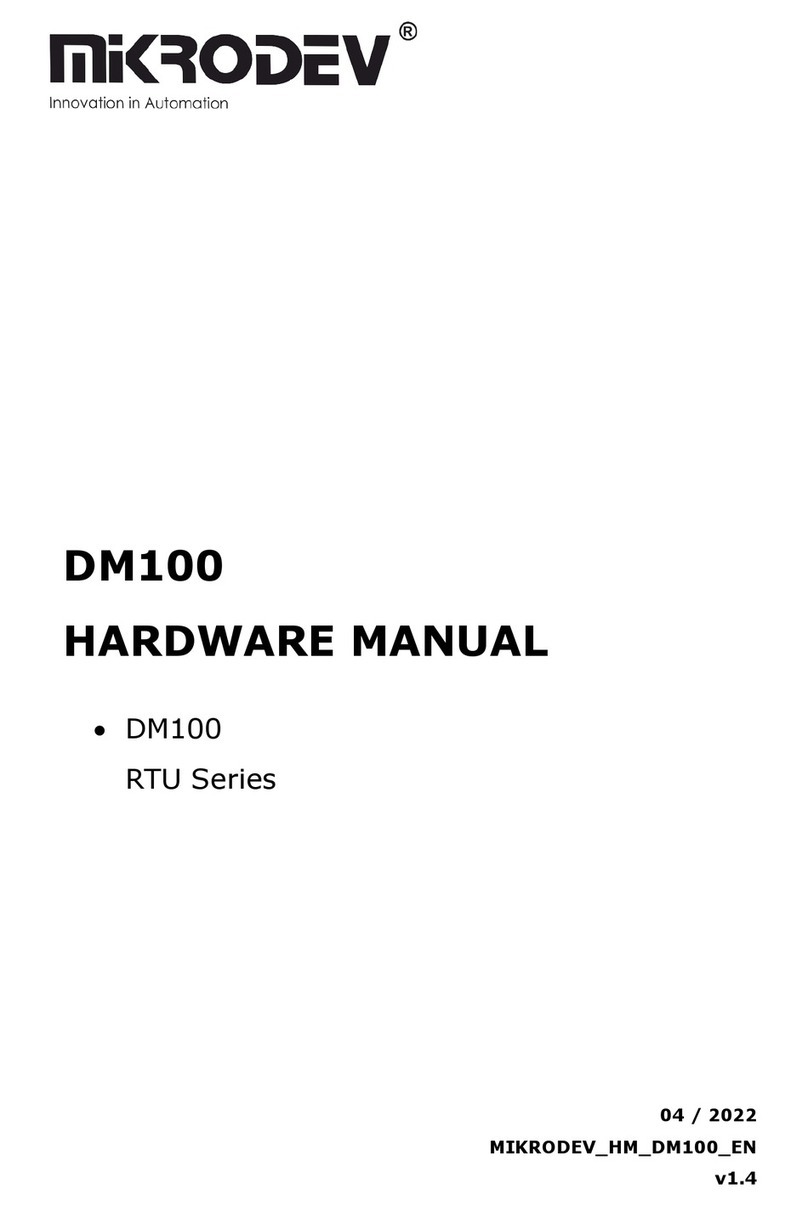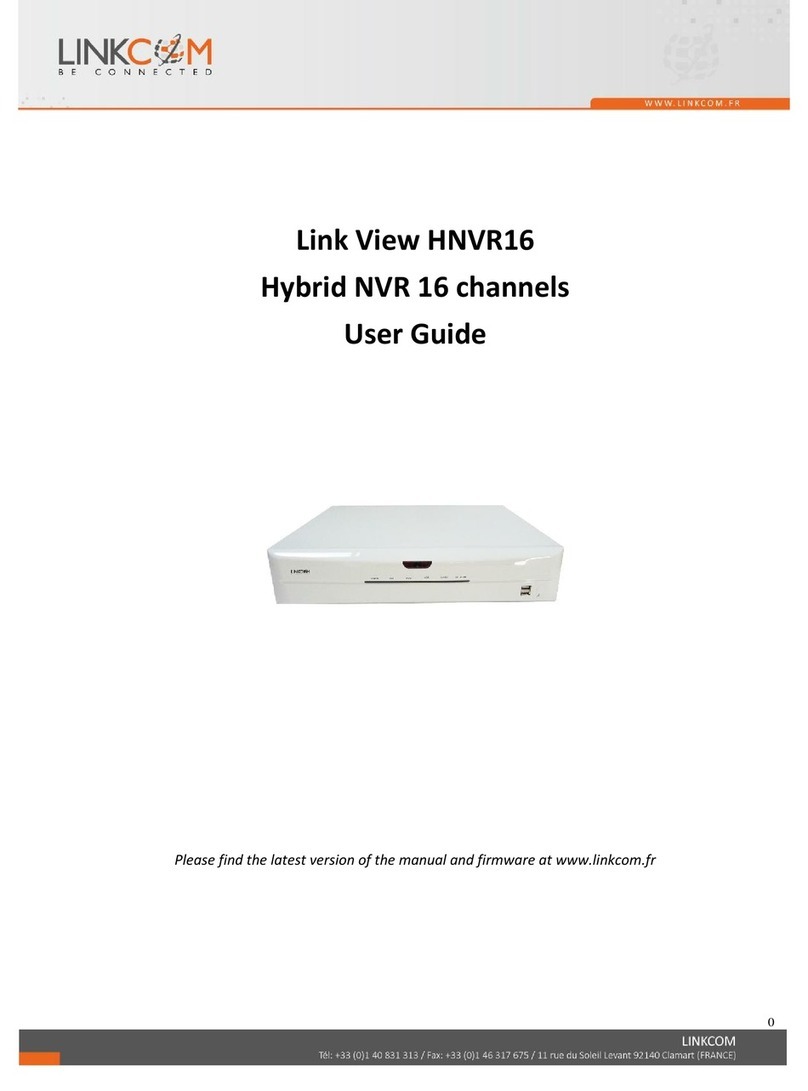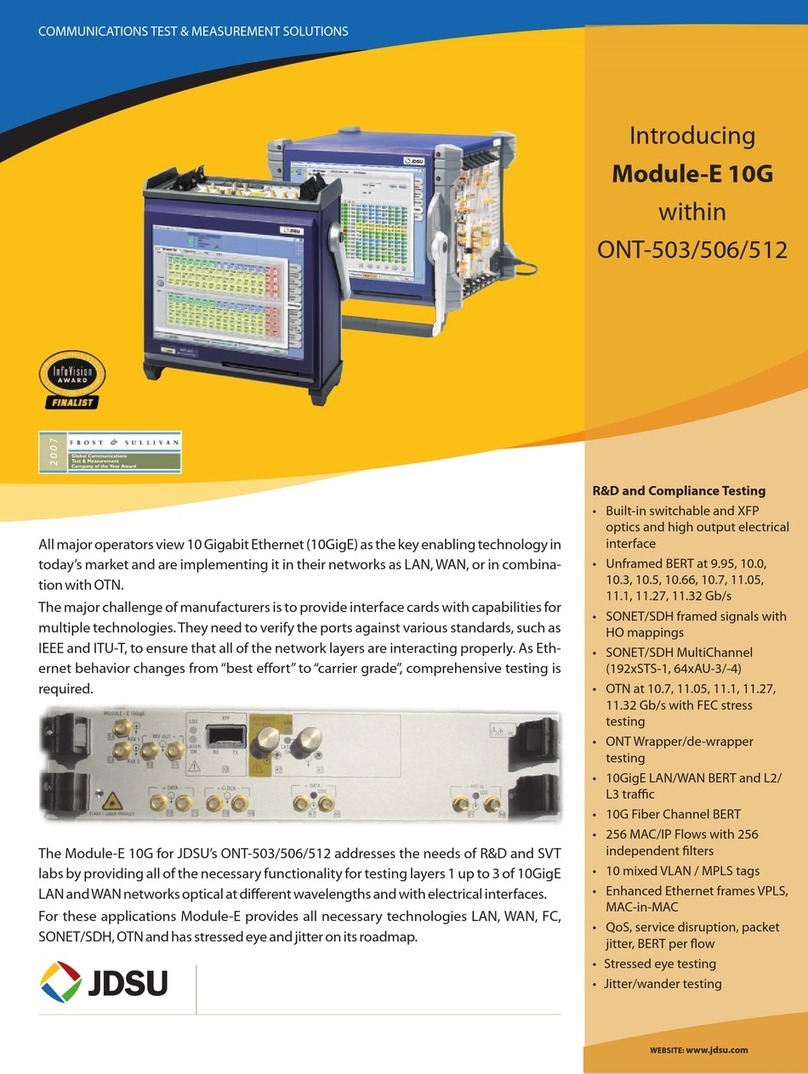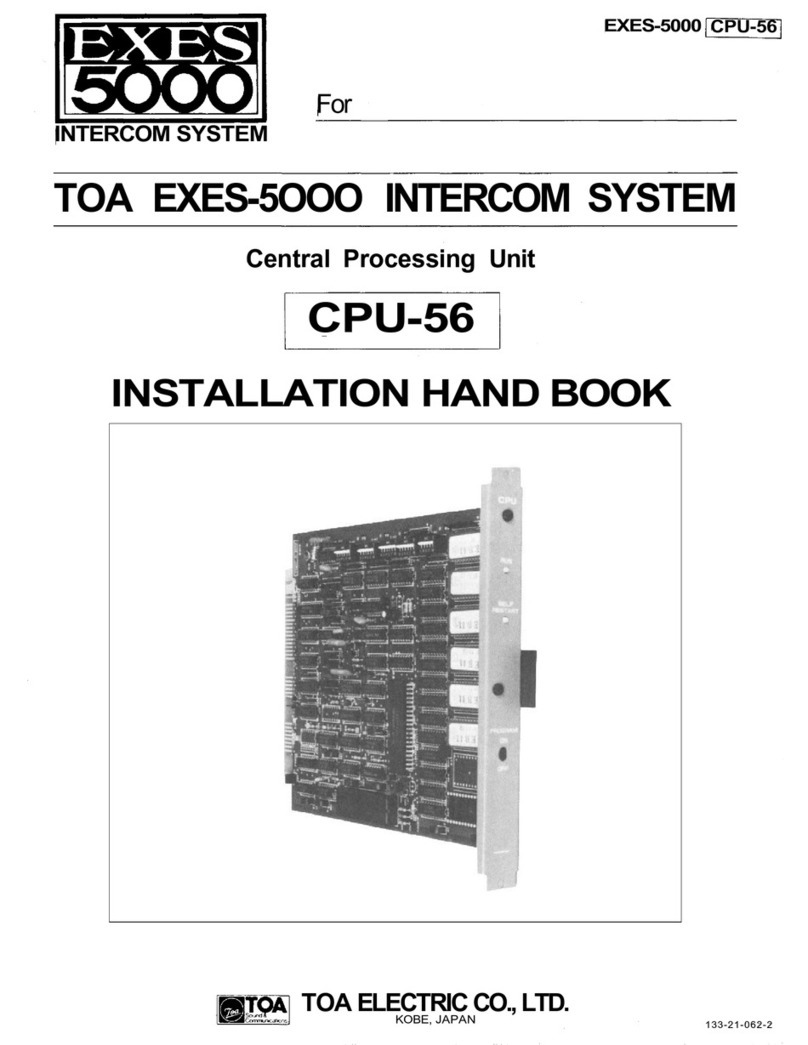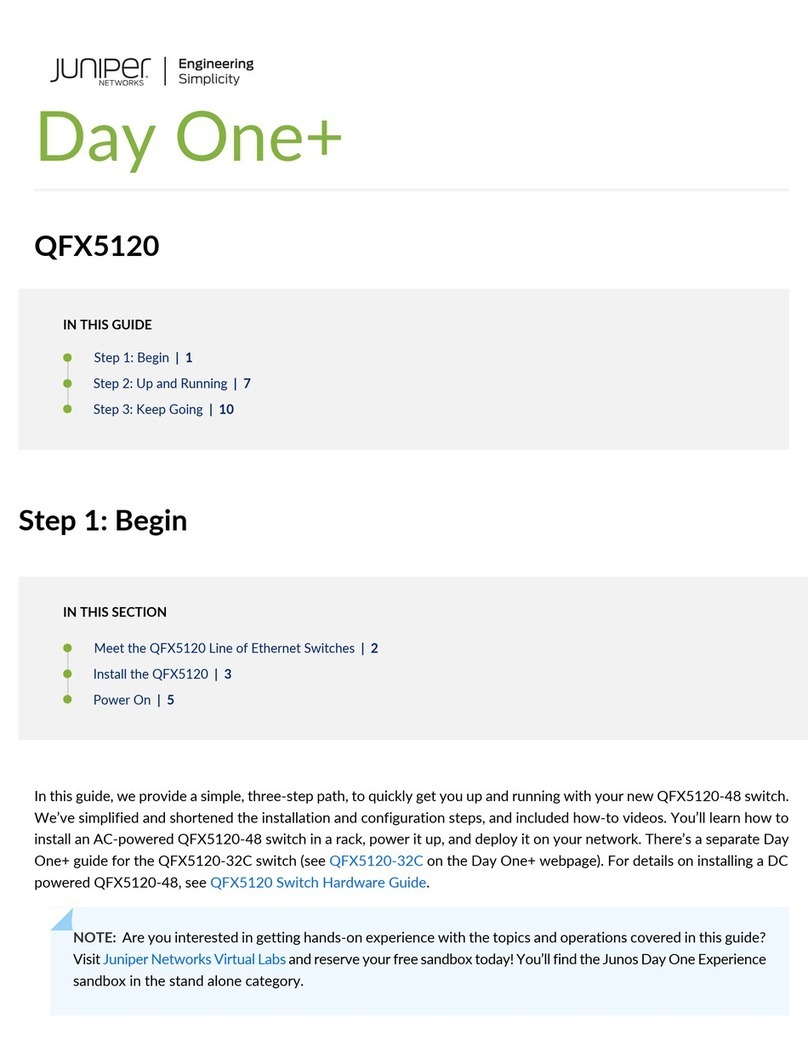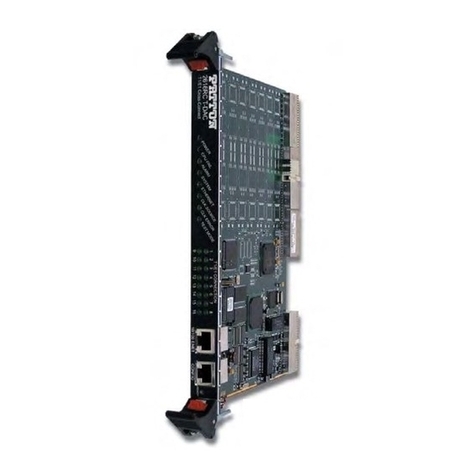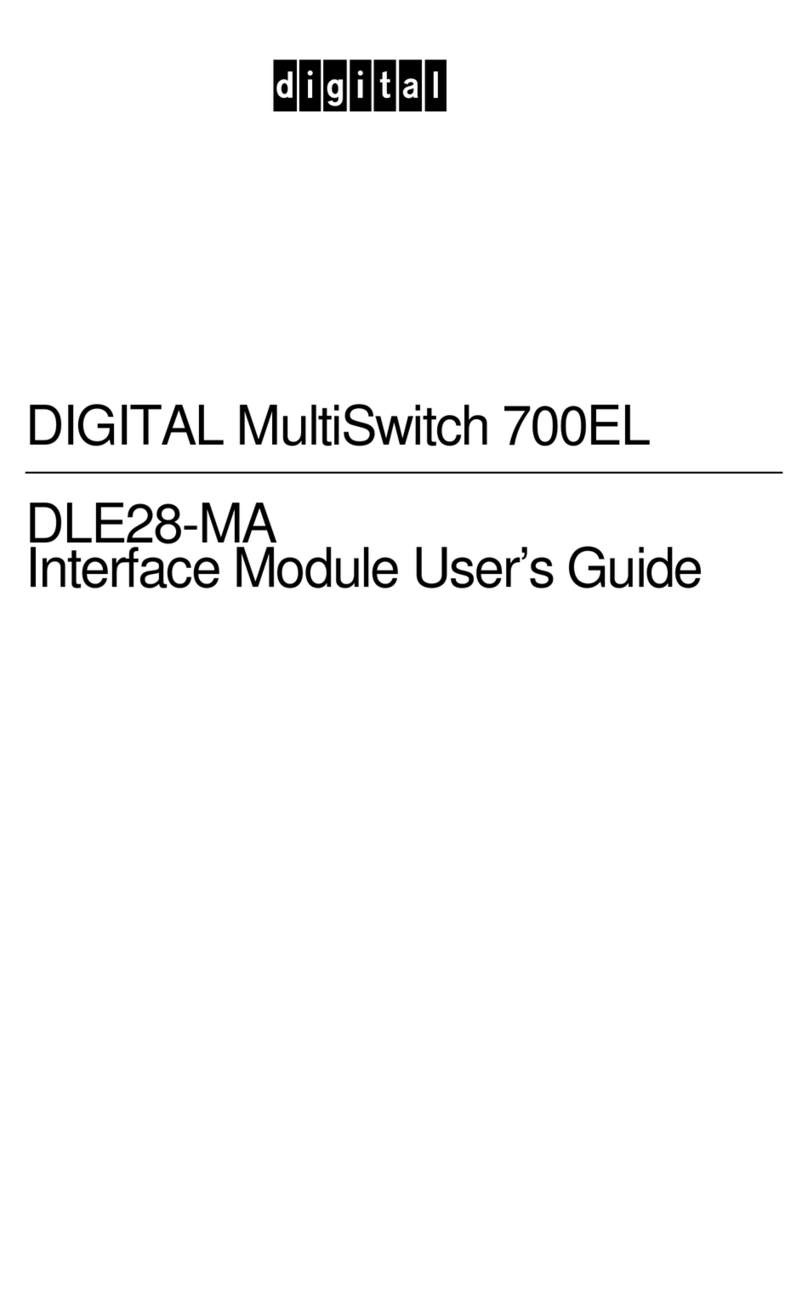General DataComm 551 User manual

Publication No. 048R138-000
Issue 8, September 2005
OPERATING AND INSTALLATION INSTRUCTIONS
FOR
DataComm 551 INTELLIGENT
CHANNEL SERVICE UNIT
General DataComm, Inc.
NAUGATUCK, CONNECTICUT
06770 U.S.A.

ATTENTION!
STATIC SENSITIVE DEVICES
PROPER HANDLING AND GROUNDING
PRECAUTIONS REQUIRED
This equipment contains electrostatic sensitive devices. Use ESD pre-
cautionary procedures when removing or inserting parts or printed circuit
(pc) cards. Keep parts and pc cards in their antistatic packaging material
until ready to install.
The use of an antistatic wrist strap, connected to the grounded
equipment frame or chassis, is recommended when handling pc cards
during installation, removal, or setting of on-board option switches. Do
not use a conductive tool, such as a screwdriver or paper clip, to set the
position of the option switches.
INSTALLATION SAFETY INSTRUCTIONS
a. Never install telephone wiring during a lightning storm.
b. Never install telephone jacks in a wet location unless the jack is specifically
c. designed for wet locations.
d. Never touch uninsulated telephone wires or terminals unless the telephone
line has been disconnected at the network interface.
e. Use caution when installing or modifying telephone lines.
CAUTION
Potentially hazardous voltages exist within this unit.

DataComm 551 INTELLIGENT
CHANNEL SERVICE UNIT
(GDC PART NOS. 048A018-001 and 048P037-001)
APPLICABILITY
This manual applies only to assembly-level Revision (P) and LATER DataComm 551 pc cards. (The
information regarding the Transcoding and Unframed Mode options applies only to assembly-level
Revision (Y) and LATER DataComm 551 pc cards.)
Use Publication No. 048R137-800 only for Revision (N) and EARLIER pc cards.
General DataComm, Inc. (GDC)
Middlebury, Connecticut 06762-1299
This product was designed and manufactured by

WARNING
This equipment generates, uses, and can radiate radio frequency energy and if not
installed and used in accordance with the instruction manual, may cause interference to
radio communications. It has been tested and found to comply with the limits for a Class
A computing device pursuant to Subpart J of Part 15 of FCC Rules, which are designed
to provide reasonable protection against such interference when operated in a
commercial environment. Operation of this equipment in a residential area is likely to
cause interference, in which case the user at his own expense will be required to take
whatever measures may be required to correct the interference.
CAUTION
To Reduce the Risk of Electrical Shock, Do Not Remove the Cover.
Refer Servicing to Qualified Service Personnel.
ACHTUNG
Um einen elektrischen Schlag zu vermeiden, nicht das Gehäuse öffnen! Änderungen
und Reparaturen dürfen nur von qualifizierten Personen auageführt werden.
CRC-REQUIRED NOTIFICATION
This equipment is a Class A digital apparatus which complies with the Radio Interference
Regulations, CRC c.1374.
PUBLICATION NOTICE
This manual has been carefully compiled and checked for accuracy. The info-mation in
this manual does not constitute a warranty of performance. Furthermore, GDC reserves
the right to revise this publication and make changes from time to time in the content
thereof. GDC assumes no liability for losses incurred as a result of out-of-date or
incorrect information contained in this manual.
READER’S COMMENTS
Comments regarding this manual should be addressed to:
Publications Department
General DataComm, Inc.
1579 Straits Turnpike
P.O Box 1299
Middlebury, CT 06762-1299
PROPRIETARY NOTICE
This publication contains information proprietary and confidential to General DataComm,
Inc. Any reproduction, disclosure, or use of this publication is expressly prohibited except
as General DataComm, Inc., may otherwise authorize in writing.
Country code configurations/default group selectable data equip. U.S. Patent No.
4841561.
Copyright, General DataComm, Inc., 1995

FCC-REQUIRED NOTIFICATION
FOR USERS OF FCC-REGISTERED EQUIPMENT
Read before using this technical manual or installing subject equipment.
This equipment complies with Part 68 of the Federal Communications Commission (FCC) Rules
and Regulations. Connection of data communication equipment to the public telephone network
is regulated by the FCC Rules and Regulations. These regulations require:
A. To connect the DC 551 to the Public Telephone Network you are required to give the
Telephone Company the following information.
1. The FCC Registration Number which is AG6 97J-60491-DE-N.
2. The FIC (Facility Interface Code) which is 04DU9-B and or 04DU9-C.
3. The SOC (Service Order Code) which is 6.0F.
4. The Telephone Company jack type which is RJ48C.
B. If you experience trouble, disconnect the equipment from the telephone line to determine if
the equipment is malfunctioning. If it is, remain disconnected until the problem is
corrected. Should this equipment cause harm to the telephone network, the telephone
company may discontinue your service temporarily. If possible they will notify you in
advance. But if advance notice is not practical, you will be notified as soon as possible. You
will be informed of your right to file a complaint with the FCC.
C. The telephone company may change its communication facilities, equipment, operations,
and procedures where reasonably required for operation. If this occurs, the telephone
company will notify you in writing.
D. It is the user's obligation to notify the telephone company prior to disconnecting equipment
from 1.544 Mbps digital service.
E. According to Part 68 of the FCC Rules and Regulations, customers are not authorized to
repair or modify this equipment. Any repair or modification will null and void the FCC
registration and the warranty of this equipment.
Rev. 3, January 1992

CANADIAN DEPARTMENT OF COMMUNICATIONS (DOC) REQUIRED NOTIFICATION
FOR USERS OF DOC-CERTIFIED EQUIPMENT
Read before using this technical manual or installing subject equipment.
The Canadian Department of Communications label identifies certified equipment. This certification
means that the equipment meets certain telecommunications network protective, operational, and
safety requirements. The Department does not guarantee the equipment will operate to the user's
satisfaction.
Before installing this equipment, users should ensure that it is permissible to be connected to the
facilities of the local telecommunications company. The equipment must also be installed using an
acceptable method of connection. In some cases, the company's inside wiring associated with a single
line individual service may be extended by means of a certified connector assembly (telephone
extension cord). The customer should be aware that compliance with the above conditions may not
prevent degradation of service in some situations.
Repairs to certified equipment should be made by an authorized Canadian maintenance facility
designated by the supplier. Any repairs or alterations made by the user to this equipment, or equipment
malfunctions, may give the telecommunications company cause to request the user to disconnect the
equipment.
Users should ensure for their own protection that the electrical ground connections of the power utility,
telephone lines, and internal metallic water pipe system, if present, are connected together. This
precaution may be particularly important in rural areas.
Caution: Users should not attempt to make such connections themselves, but should contact the
appropriate electric inspection authority, or electrician, as appropriate.
CANADIAN EMISSIONS REQUIREMENTS
“This digital apparatus does not exceed the (ClassA) limits for radio noise emissions from
digital apparatus set out in the Radio Interference Regulations of the Canadian Department of
Communications.”

AFFIDAVIT FOR THE CONNECTION OF CUSTOMER PREMISES
EQUIPMENT
TO 1.544 Mbps AND/OR SUBRATE DIGITAL SERVICES
For work to be performed in the certified territory of
(Telco’s Name)
State of:
County of:
I, ,
(Name) Business Address
representing ,
(Name of Customer)
being duly sworn, state:
(Telephone Number)
I have the responsibility for the operation and maintenance of the terminal equipment to be
connected to 1.544 Mbps and/or subrate digital
services. The terminal equipment to be connected complies with Part 68 of the Commission’s
rules except for the encoded analog content and billing protection specifications. With respect
to encoded analog content and billing protection:
qI attest that all operations associated with the establishment, maintenance and
adjustment of the digital CPE with respect to encoded analog content and encoded
billing information continuously complies with Part 68 of FCC’s Rules and
Regulations.
qThe digital CPE does not transmit digital signals containing encoded analog
content or billing information which is intended to be decoded within the
telecommunications network.
qThe encoded analog and billing protection is factory set and is not under the
control of the customer.

I attest that the operator(s)/maintainer(s) of the digital CPE responsible for the establish-
ment, maintenance and adjustment of the encoded analog content and billing information
has (have) been trained to perform these functions by successfully completing one of the
following: (Check appropriate one(s) ).
a. A training course provided by the manufacturer/grantee of the equipment
used to encode analog signals
b. A training course provided by the customer or authorized representative,
using training materials and instructions provided by the manufacturer/
grantee of the equipment used to encode analog signals
c. An independent training course (e.g., trade school or technical institution)
recognized by the manufacturer/grantee of the equipment used to encode
analog signals
d. In lieu of the preceeding training requirements, the operator(s)/maintain-
er(s) is (are) under the control of a supervisor trained in accordance with
above.
(Circle One)
I agree to provide with proper documentation
(Telco’s Name)
to demonstrate compliance with the information as provided in the preceding para-graph, if
so requested.
(Signature)
(Title)
(Date)
Subscribed and Sworn to before me
this day of 19 .
Notary Public
My Commission expires:

READER SURVEY
Help us to produce a better manual by returning this page with your comments.
Name of Manual ____________________ Publication No. _________________ Issue No. ___
Overall rating of this manual Excellent Good Adequate Poor
Readability of text Very clear Good Adequate Poor
Installation Instructions Very clear Good Adequate Poor
Usefulness of graphics Useful Good Adequate Poor
Is this manual User Friendly? Yes Partly No
Did you find any errors? Yes No
If so, describe (List page No.) _____________________________________________________
_________________________________________________________________________________
_________________________________________________________________________________
_________________________________________________________________________________
_________________________________________________________________________________
Do you recommend additions/changes? Yes No
If so, describe ____________________________________________________________________
__________________________________________________________________________________
__________________________________________________________________________________
__________________________________________________________________________________
__________________________________________________________________________________
Any additional comments? ________________________________________________________
__________________________________________________________________________________
__________________________________________________________________________________
__________________________________________________________________________________
Name __________________________Title _____________________ Date__________________
Company _________________________________________________ Mail Drop_____________
City __________________________ State ____________ Zip Code or Country _____________
Telephone Number if you want us to call you ( ____ ) _____ - _________
Copy or remove this page and mail to:
Publications Department
Technology Center
General DataComm Industries, Inc.
Middlebury, Ct 06762-1299


TABLE OF CONTENTS
Section &
Subject Page
1 — INTRODUCTION
DataComm 551 FEATURES.........................................................................................................................1-1
DESCRIPTION ............................................................................................................................................1-1
DIAGNOSTICS ............................................................................................................................................1-2
APPLICATIONS..........................................................................................................................................1-3
BACKWARD COMPATIBILITY.................................................................................................................1-6
SERVICE AND TRAINING ........................................................................................................................1-6
2 — INSTALLATION
OVERVIEW .................................................................................................................................................2-1
UNPACKING AND HANDLING................................................................................................................2-1
PREOPERATIONAL CHECK .....................................................................................................................2-1
INSTALLATION PROCEDURES................................................................................................................2-1
OPTION SELECTION .................................................................................................................................2-5
Master/Slave CSU Option ..........................................................................................................................2-5
Option Selection in an Installation with a MAU-1A.................................................................................2-9
ELECTRICAL CONNECTIONS..................................................................................................................2-14
Equipment Connection ..............................................................................................................................2-14
Network Interface Connection ..................................................................................................................2-15
Supervisory Terminal Connection ...........................................................................................................2-23
Primary Power Connection.......................................................................................................................2-26
3 — OPERATION
OVERVIEW .................................................................................................................................................3-1
FRONT PANEL INDICATORS, TEST JACKS, AND SWITCHES...........................................................3-1
SUPERVISORY TERMINAL OPERATING PROCEDURES.....................................................................3-1
Accessing a CSU........................................................................................................................................3-1
Master/Slave CSU Option ..........................................................................................................................3-7
The Log-On Screen ....................................................................................................................................3-8
Display Information..................................................................................................................................3-9
Using the Keyboard....................................................................................................................................3-10
The Main Menu.........................................................................................................................................3-10
The DS1 Diagnostics Menu .......................................................................................................................3-12
The DS0 Diagnostics Screen .....................................................................................................................3-28
The CSU Configuration Screen .................................................................................................................3-30
The Maintenance Screen ..........................................................................................................................3-35
i

TABLE OF CONTENTS (Cont.)
Section &
Subject Page
4 — TESTS
OVERVIEW.................................................................................................................................................4-1
DS1 LOOPBACK FUNCTIONS...................................................................................................................4-4
DS1 Line Loopback Function.....................................................................................................................4-4
DS1 Network Interface Loopback Function...............................................................................................4-5
DS1 Test Loopback Function.....................................................................................................................4-6
DS1 DIAGNOSTICS.....................................................................................................................................4-7
DS1 Line Loop............................................................................................................................................4-7
DS1 Local Test...........................................................................................................................................4-8
DS1 Local Test with Self-Test....................................................................................................................4-9
DS1 Network Interface Loopback..............................................................................................................4-10
DS1 Network Interface Loopback with Self-Test.......................................................................................4-11
DS1 Remote Test........................................................................................................................................4-12
DS1 Remote Test with Self-Test.................................................................................................................4-14
DS1 Self-Test..............................................................................................................................................4-16
DS1 Test Loop.............................................................................................................................................4-18
DS0 DIAGNOSTICS.....................................................................................................................................4-19
DS0 Circuit Delay Measurement Test.......................................................................................................4-19
DS0 Remote Test........................................................................................................................................4-21
DS0 Remote Test with Self-Test.................................................................................................................4-22
DS0 Self-Test..............................................................................................................................................4-23
TECHNICAL ASSISTANCE PROCEDURE................................................................................................4-27
TRAINING..................................................................................................................................................4-28
APPENDIX A — TECHNICAL INFORMATION
APPENDIX B — GLOSSARY
INDEX
ii

TABLE OF CONTENTS
iii
LIST OF ILLUSTRATIONS
Section &
Figure Page
1 — INTRODUCTION
1-1 TYPICAL NETWORK, LOCAL TERMINAL CONTROL ....................................................................1-7
1-2 TYPICAL NETWORK, REMOTE TERMINAL CONTROL USING MODEMS ....................................1-7
1-3 TYPICAL NETWORK, LOCAL TERMINAL CONTROL USING PMC-100s WITH DIAL BACKUP......1-8
1-4 TYPICAL NETWORK, REMOTE TERMINAL CONTROL USING PMC-100s WITH DIAL BACKUP ..1-9
1-5 TYPICAL NETWORK, REMOTE TERMINAL CONTROL USING PMC-100s WITH EXPANSION
AND DIAL BACKUP .....................................................................................................................1-10
2 —INSTALLATION
2-1 OPTION LOCATION.......................................................................................................................2-2
2-2 DataComm ENCLOSURE COVER REMOVAL PROCEDURE.........................................................2-4
2-3 OPTION SWITCH AND JUMPER SELECTIONS (2 Sheets)..........................................................2-11
2-4 IN-BAND COMMUNICATION PATH..............................................................................................2-13
2-5 OUT-OF-BAND COMMUNICATION PATH....................................................................................2-13
2-6 DataComm ENCLOSURE INSTALLATION. ................................................................................. 2-16
2-7 DataComm FOURPAK ENCLOSURE INSTALLATION..................................................................2-17
2-8 DataComm MODEM SHELF INSTALLATION................................................................................2-18
2-9 GDC TRIPAK SHELF INSTALLATION ..........................................................................................2-19
2-10 UNIVERSAL SYSTEM SHELF INSTALLATION.............................................................................2-20
2-11 SPAN POWER OPTIONS.............................................................................................................2-22
2-12 SUPERVISORY TERMINAL MODEM APPLICATION....................................................................2-25
3 —OPERATION
3-1 FRONT PANEL INDICATORS.........................................................................................................3-2
3-2 FRONT PANEL ACCESS TEST JACKS..........................................................................................3-3
3-3 FRONT PANEL SWITCHES............................................................................................................3-4
3-4 MENU ORGANIZATION................................................................................................................. 3-5
3-5 LOG-ON SCREEN .........................................................................................................................3-8
3-6 MAIN MENU...................................................................................................................................3-9
3-7 DS1 DIAGNOSTICS MENU ..........................................................................................................3-13
3-8 ERROR DESCRIPTION................................................................................................................3-14
3-9 ALARM COUNTS SCREEN ..........................................................................................................3-15
3-10 ONE HOUR REPORT SCREEN....................................................................................................3-18
3-11 TWENTY-FOUR HOUR REPORT SCREEN..................................................................................3-20
3-12 SCHEDULED PERFORMANCE REPORT SCREEN......................................................................3-22
3-13 DS1 SELF TEST SCREEN............................................................................................................3-23
3-14 LOOPBACKS SCREEN ................................................................................................................3-25

TABLE OF CONTENTS
LIST OF ILLUSTRATIONS (Cont.)
Section &
Figure Page
3-15 RECEIVE LEVEL SCREEN..............................................................................................................3-27
3-16 DS0 DIAGNOSTICS SCREEN..........................................................................................................3-28
3-17 CSU CONFIGURATION SCREEN...................................................................................................3-32
3-18 MAINTENANCE SCREEN..............................................................................................................3-36
4 — TESTS
4-1 TROUBLE DIAGNOSTIC FLOWCHART.......................................................................................4-3
4-2 DS1 LINE LOOPBACK FUNCTION................................................................................................4-4
4-3 DS1 NETWORK INTERFACE LOOPBACK FUNCTION...............................................................4-5
4-4 DS1 TEST LOOPBACK FUNCTION...............................................................................................4-6
4-5 DS1 LINE LOOP................................................................................................................................4-7
4-6 DS1 LOCAL TEST.............................................................................................................................4-8
4-7 DS1 LOCAL TEST WITH SELF-TEST............................................................................................4-9
4-8 DS1 NETWORK INTERFACE LOOPBACK....................................................................................4-10
4-9 DS1 NETWORK INTERFACE LOOPBACK WITH SELF-TEST...................................................4-11
4-10 DS1 REMOTE TEST WITH LINE LOOPBACK..............................................................................4-13
4-11 DS1 REMOTE TEST WITH TEST LOOPBACK.............................................................................4-13
4-12 DS1 REMOTE TEST WITH LINE LOOPBACK AND SELF-TEST................................................4-15
4-13 DS1 REMOTE TEST WITH TEST LOOPBACK AND SELF-TEST...............................................4-15
4-14 DS1 END-TO-END SELF-TEST.......................................................................................................4-17
4-15 DS1 TEST LOOP...............................................................................................................................4-18
4-16 DS0 CIRCUIT DELAY MEASUREMENT TEST.............................................................................4-20
4-17 DS0 REMOTE TEST.........................................................................................................................4-21
4-18 DS0 REMOTE TEST WITH SELF-TEST.........................................................................................4-22
4-19 DS0 END-TO-END SELF-TEST.......................................................................................................4-24
4-20 SUMMARY OF TESTS (2 Sheets)............................................................................... ...................4-25
iv

TABLE OF CONTENTS
LIST OF TABLES
Section &
Table Page
1 — INTRODUCTION
1-1 HOUSINGS FOR DataComm 551 AND RELATED PRODUCTS.....................................................1-3
1-2 EQUIPMENT LIST...........................................................................................................................1-4
2 — INSTALLATION
2-1 OPTION APPLICATION NOTES (2 Sheets)...................................................................................2-6
2-2 CSU ADDRESS SELECTION............................................................................................................2-10
3 — OPERATION
3-1 STATUS LINE INDICATORS (2 Sheets).........................................................................................3-11
4 — TESTS
4-1 DS1 LINE LOOP................................................................................................................................4-7
4-2 DS1 LOCAL TEST.............................................................................................................................4-8
4-3 DS1 LOCAL TEST WITH SELF-TEST............................................................................................4-9
4-4 DS1 NETWORK INTERFACE LOOPBACK....................................................................................4-10
4-5 DS1 NETWORK INTERFACE LOOPBACK WITH SELF-TEST...................................................4-11
4-6 DS1 REMOTE TEST.........................................................................................................................4-12
4-7 DS1 REMOTE TEST WITH SELF-TEST.........................................................................................4-14
4-8 DS1 END-TO-END SELF-TEST.......................................................................................................4-16
4-9 DS1 TEST LOOP...............................................................................................................................4-18
4-10 DS0 CIRCUIT DELAY MEASUREMENT TEST.............................................................................4-19
4-11 DS0 REMOTE TEST.........................................................................................................................4-21
4-12 DS0 REMOTE TEST WITH SELF-TEST.........................................................................................4-22
4-13 DS0 END-TO-END SELF-TEST.......................................................................................................4-23
v


SECTION 1
INTRODUCTION
DataComm 551
FEATURES •Auto Framing adapts the DataComm 551 automatically to Extended Su-
perframe Format (ESF) or D4 Superframe Format on both the customer
equipment and the network sides
•Supports both Alternate Mark Inversion (AMI) and Bipolar with 8 Zero
Substitution (B8ZS) line codes, and allows a variety of options for ones
density in the data stream
•Supports both AT&T PUB 54016 and Bellcore TR-TSY-000194 (ANSI)
procedures for the collection and monitoring (via the Supervisory ter-
minal) of the network TABS Maintenance Messages and Performance
Report Messages provided by the Central Office
•Provides two independent register sets for TABS performance data so
that the user set is unaffected when the Central Office clears the net-
work set
•Link-level (DS1) and channel-level (DS0) diagnostics provide exten-
sive diagnostic capabilities
•Supervisory terminal provides software-control of configuration, diag-
nostics, and maintenance
•Supports GDC’s PMC-100 Performance Monitor Card for enhanced, cen-
tralized network control
DESCRIPTION The DataComm 551 Intelligent Channel Service Unit (CSU) provides the
interface between the customer's 1.544 Mbps T1 equipment (e.g., one of
GDC's MEGASWITCH®, MEGAMUX®, or MEGAMUX PLUS multi-
plexers) and the T1 digital carrier facility provided by the Telco or other
carrier. The DataComm 551 provides the normal CSU functions of net-
work interfacing and protection, as well as a host of other flexible and
powerful features, including:
•The DataComm 551 can be pre-equalized for line lengths of up to 655
feet (199.6 m) on the customer equipment side.
•The DataComm 551 can perform automatic Line Build-Out (signal at-
tenuation) of 0, 7.5 , or 15 dB at 772KHz on the network side.
1-1

INTRODUCTION
•The DataComm 551 detects both network- and customer equipment-gen-
erated errors and alarms, stores the number of occurrences of each,
and transmits the appropriate alarms to both ends.
•The DataComm 551 transmits a keep alive signal to the network when
it detects a loss of signal from the customer equipment side.
•The DataComm 551 can perform a variety of loopbacks and other tests.
•The DataComm 551 can provide power to the T1 span (in DataComm
FourPak, GDC TriPak, and Universal System Shelf installations, us-
ing a Telco-provided current source)
•The DataComm 551 can can be configured as a slave CSU, limiting the
configuration changes and diagnostics available via the Supervisory
terminal. This prevents actions which could disrupt service.
The DataComm 551 can be mounted in the following housings:
•Standalone single-slot DataComm Enclosure (model DE-7)
•Standalone four-slot DataComm FourPak Enclosure (model DFP-11)
•Rack-mountable sixteen-slot DataComm Modem Shelf (models DS-1,
DS-5R, and DS-5NR)
•Rack-mountable three-slot GDC TriPak Shelf (models TPS-1 and TPS-
2)
•Rack-mountable four-slot Universal System Shelf backplane (models
USS-1D, USS-1-DC/R, and USS-1-DC/NR)
(All rack-mountable housings fit into 19- and 23-inch wide equipment
racks.)
Table 1-1 shows which related products can be installed with the
DataComm 551 in these housings.
DIAGNOSTICS The DataComm 551 offers the following link-level (DS1) diagnostics:
•Alarm counts display
•ANSI Payload Loopback (PLB)
•AT&T DTE Loopback (DLB)
•AT&T TABS Maintenance Message Protocol support
•Bellcore Performance Report Messages support
•DS1 End-to-End Self-Test
•DS1 Line Loop
1-2

INTRODUCTION
TABLE 1-1. HOUSINGS FOR DataComm 551 AND RELATED PRODUCTS
Housing
Product DE-7 DFP-11
DS-1
DS-5R
DS-5NR TPS-1
TPS-2
USS-1D
USS-1-DC/R
USS-1 DC/NR
DataComm 551 CSU √√√√ √
DataComm 552 DSU √√√√ √
PMC-100 Performance Monitor Card √ √
DataComm 596 Modem √ √ √ √
•DS1 Local Test (LT)
•DS1 Local Test with Self-Test
•DS1 Network Interface Loopback
•DS1 Network Interface Loopback with Self-Test
•DS1 Remote Test (RT)
•DS1 Remote Test with Self-Test
•DS1 Test Loop
It also offers the following channel-level (DS0) diagnostics:
•DS0 Circuit Delay Measurement Test
•DS0 End-to-End Self-Test
•DS0 Remote Test
•DS0 Remote Test with Self-Test
The DataComm 551 also allows the user to set the time and date, display
the firmware revision level, and reset the CSU.
Note that some of these functions require the use of the Supervisory ter-
minal. Refer to Supervisory Terminal Operating Procedures in Section 3
for further discussion.
Part numbers for the DataComm 551 are listed in Table 1-2.
APPLICATIONS The DataComm 551 is used in pairs in a point-to-point data network over
a T1 link, with one CSU on each end providing the interface between the
T1-compatible customer equipment and the T1 link.
1-3

INTRODUCTION
TABLE 1-2. EQUIPMENT LIST
Description GDC Part No.
GDC DataComm 551 Intelligent CSU, standalone single-slot enclosure model DE-7, 117 V ac 048A018-001
GDC DataComm 551 Intelligent CSU, rackmount pc card 048P037-001
Mounting Enclosures and Shelves
DataComm FourPak Enclosure model DFP-11, standalone, 117 V ac 010B115-001
DataComm Modem Shelf, rackmount
Model DS-1, 117 V ac 010B015-001
Model DS-5R, dc-powered with redundant power supplies 010M011-001
Model DS-5NR, dc-powered with non-redundant power supply 010M011-002
GDC TriPak Shelf, rackmount
Model TPS-1, 117 V ac 010B124-001
Model TPS-2, 48 V dc 010B125-001
Universal System Shelf, rackmount
Model USS-1D, 117 V ac 010B080-001
Model USS-1-DC/R, dc-powered with redundant power supplies 010M040-002
Model USS-1-DC/NR, dc-powered with non-redundant power supply 010M040-001
CSU-551 Backplane (for Universal System Shelf installation) 048B015-001
Cables
Customer Equipment Cables
Adapter cable, DB25P male (with screws) to DB15S female (with slidelock posts) (CSU to
customer equipment; use when replacing GDC 551A/S1 CSU) (1 foot) 027H230-005
Adapter cable, DB25P male to DB15S female (CSU to customer equipment with DB15P male
connector) (3 feet) 027H324-002
Interface cable, DB25P male to DB25P male (CSU to customer equipment with DB25S female
connector) (3- to 100-ft lengths) 027H227-XXX
Front Panel Cables
Bantam-to-WECO 310 Adapter Plug 209-026-S001
Front panel access test jack patch cable (male-to-male) (24- and 60-inch lengths) 830-005-XXX
Front panel access test jack patch cable Bantam-to-WECO 310 (4 feet) 830-021-S001
Network Cables
Adapter cable, RJ48C plug to DB15P male (with slidelock posts) (CSU to local exchange
carrier; use when replacing GDC 551A/S1 CSU) (1 foot) 022H022-010
Interface cable, RJ48 to RJ48 (CSU to local exchange carrier) (10- to 50-ft lengths) 022H024-XXX
Interface cable, RJ48 to terminal lugs (CSU to local exchange carrier) (10- to 50-ft lengths) 022H021-XXX
Network Cables (DataComm Modem Shelf only)
Adapter cable, RJ48C plug-to-plug (CSU to local exchange carrier for a DataComm Modem
Shelf housing only; use with coupler 209-038-002) 027H242-X04
Coupler, RJ48C jack-to-jack (use with adapter cable 027H242-X04) 209-038-002
Interface cable, RJ48C plug-to-terminal lugs (CSU to local exchange carrier for a DataComm
Modem Shelf housing only) (10- to 50-foot lengths) 022H025-XXX
Supervisory Terminal Cables
Interface cable (PMC-100 to Supervisory terminal or DataComm 551) (2- to 100-ft lengths) 028H511-XXX
Interface cable (Supervisory terminal to DataComm 551) (1- to 25-ft lengths) 028H507-XXX
1-4
Table of contents
Other General DataComm Network Hardware manuals

General DataComm
General DataComm SpectraComm SDT User manual

General DataComm
General DataComm SpectraComm 800 T3 User manual
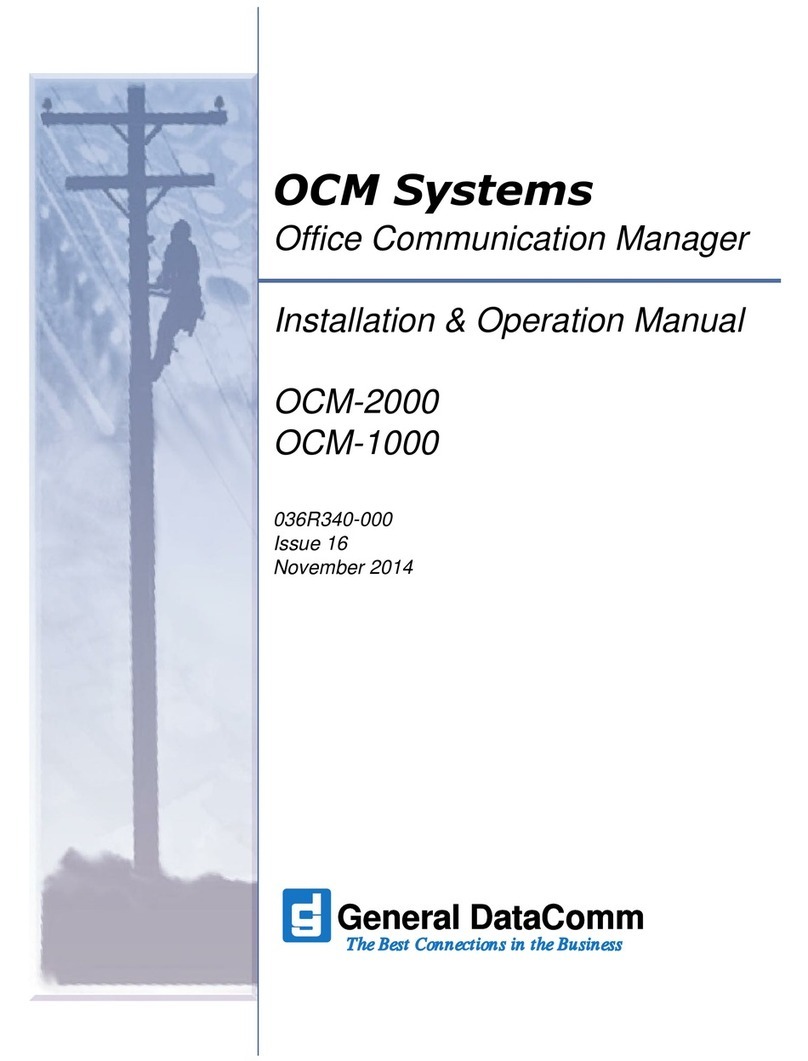
General DataComm
General DataComm OCM-2000 User manual
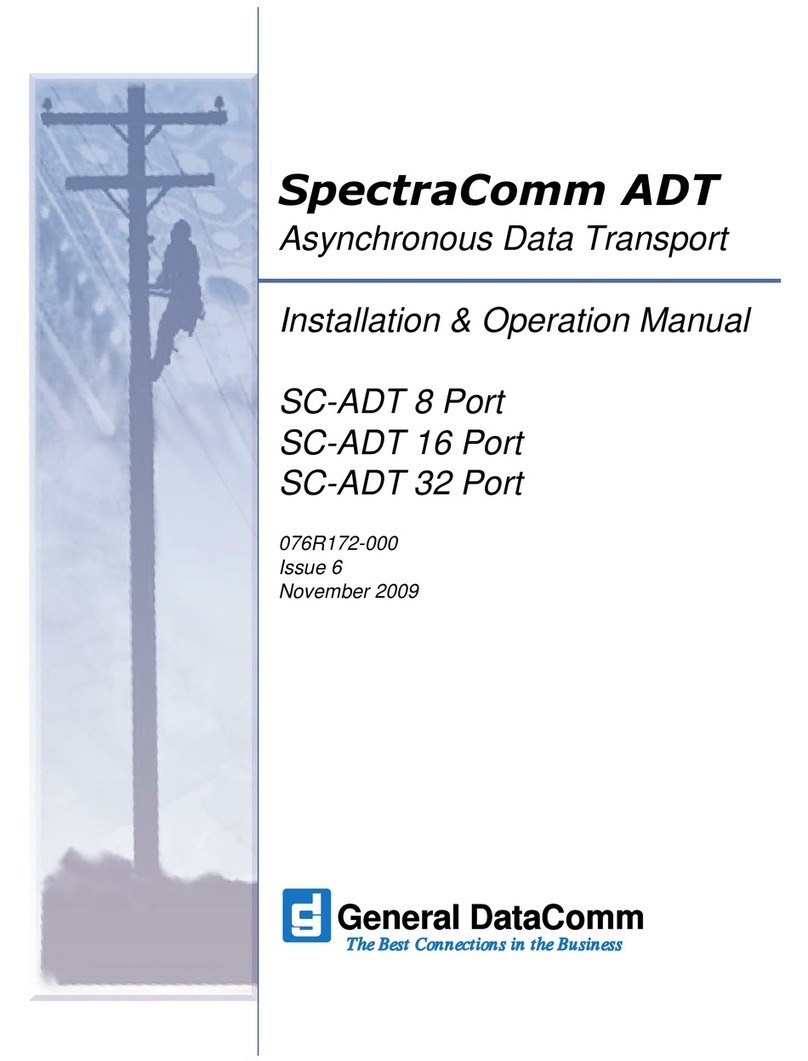
General DataComm
General DataComm SC-ADT 8 Port User manual

General DataComm
General DataComm DeskTop T1 Owner's manual

General DataComm
General DataComm SpectraComm 553 Owner's manual
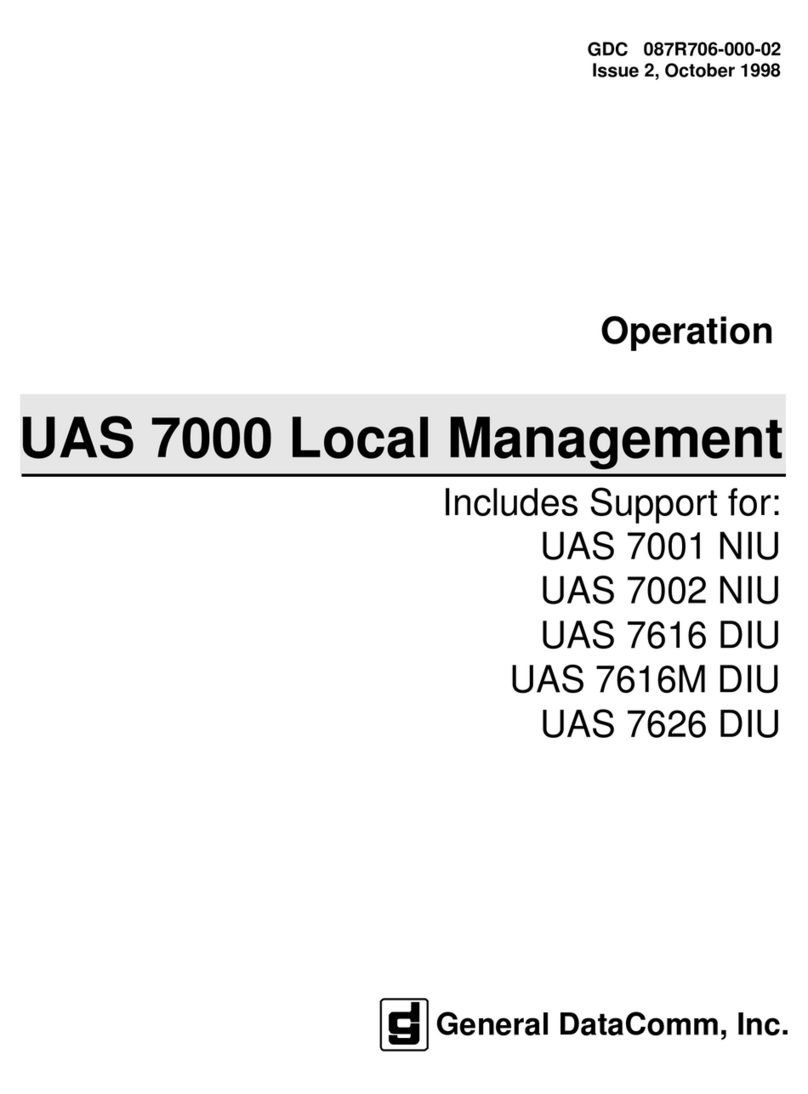
General DataComm
General DataComm UAS 7000 Instruction Manual
